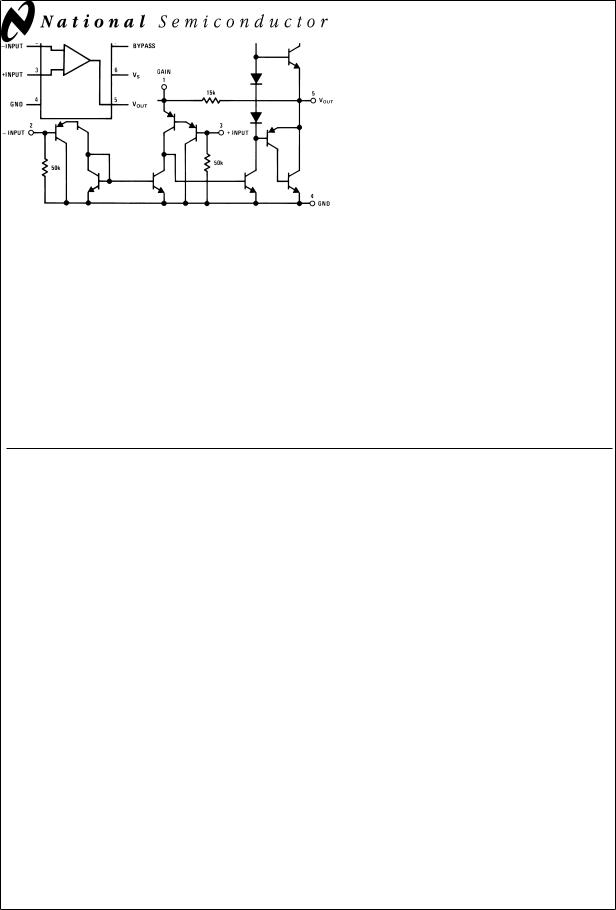NSC LM386N-1, LM386MX-1, LM386MMX-1, LM386MDC, LM386M-1 Datasheet
...
January 2000
LM386
Low Voltage Audio Power Amplifier
General Description
The LM386 is a power amplifier designed for use in low voltage consumer applications. The gain is internally set to 20 to keep external part count low, but the addition of an external resistor and capacitor between pins 1 and 8 will increase the gain to any value up to 200.
The inputs are ground referenced while the output is automatically biased to one half the supply voltage. The quiescent power drain is only 24 milliwatts when operating from a 6 volt supply, making the LM386 ideal for battery operation.
Features
nBattery operation
nMinimum external parts
nWide supply voltage range: 4V±12V or 5V±18V
nLow quiescent current drain: 4 mA
nVoltage gains from 20 to 200
nGround referenced input
nSelf-centering output quiescent voltage
nLow distortion
nAvailable in 8 pin MSOP package
Applications
n AM-FM radio amplifiers
n Portable tape player amplifiers n Intercoms
n TV sound systems n Line drivers
n Ultrasonic drivers n Small servo drivers n Power converters
Equivalent Schematic and Connection Diagrams
Small Outline,
Molded Mini Small Outline,
and Dual-In-Line Packages
DS006976-2
Top View
Order Number LM386M-1,
DS006976-1 LM386MM-1, LM386N-1,
LM386N-3 or LM386N-4
See NS Package Number
M08A, MUA08A or N08E
Amplifier Power Audio Voltage Low LM386
© 2000 National Semiconductor Corporation |
DS006976 |
www.national.com |

LM386
Absolute Maximum Ratings (Note 2)
If Military/Aerospace specified devices are required, please contact the National Semiconductor Sales Office/ Distributors for availability and specifications.
Supply Voltage |
|
(LM386N-1, -3, LM386M-1) |
15V |
Supply Voltage (LM386N-4) |
22V |
Package Dissipation (Note 3) |
|
(LM386N) |
1.25W |
(LM386M) |
0.73W |
(LM386MM-1) |
0.595W |
Input Voltage |
±0.4V |
Storage Temperature |
−65ÊC to +150ÊC |
Operating Temperature |
0ÊC to +70ÊC |
Junction Temperature |
+150ÊC |
Soldering Information |
|
Dual-In-Line Package |
|
Soldering (10 sec) |
+260ÊC |
Small Outline Package |
|
(SOIC and MSOP) |
|
Vapor Phase (60 sec) |
+215ÊC |
Infrared (15 sec) |
+220ÊC |
See AN-450 ªSurface Mounting Methods and Their Effect on Product Reliabilityº for other methods of soldering surface mount devices.
Thermal Resistance |
|
θJC (DIP) |
37ÊC/W |
θJA (DIP) |
107ÊC/W |
θJC (SO Package) |
35ÊC/W |
θJA (SO Package) |
172ÊC/W |
θJA (MSOP) |
210ÊC/W |
θJC (MSOP) |
56ÊC/W |
Electrical Characteristics (Notes 1, 2)
TA = 25ÊC
Parameter |
Conditions |
Min |
Typ |
Max |
Units |
|
|
|
|
|
|
Operating Supply Voltage (VS) |
|
|
|
|
|
LM386N-1, -3, LM386M-1, LM386MM-1 |
|
4 |
|
12 |
V |
LM386N-4 |
|
5 |
|
18 |
V |
|
|
|
|
|
|
Quiescent Current (IQ) |
VS = 6V, VIN = 0 |
|
4 |
8 |
mA |
Output Power (POUT) |
|
|
|
|
|
LM386N-1, LM386M-1, LM386MM-1 |
VS = 6V, RL = 8Ω, THD = 10% |
250 |
325 |
|
mW |
LM386N-3 |
VS = 9V, RL = 8Ω, THD = 10% |
500 |
700 |
|
mW |
LM386N-4 |
VS = 16V, RL = 32Ω, THD = 10% |
700 |
1000 |
|
mW |
Voltage Gain (AV) |
VS = 6V, f = 1 kHz |
|
26 |
|
dB |
|
10 µF from Pin 1 to 8 |
|
46 |
|
dB |
|
|
|
|
|
|
Bandwidth (BW) |
VS = 6V, Pins 1 and 8 Open |
|
300 |
|
kHz |
Total Harmonic Distortion (THD) |
VS = 6V, RL = 8Ω, POUT = 125 mW |
|
0.2 |
|
% |
|
f = 1 kHz, Pins 1 and 8 Open |
|
|
|
|
|
|
|
|
|
|
Power Supply Rejection Ratio (PSRR) |
VS = 6V, f = 1 kHz, CBYPASS = 10 µF |
|
50 |
|
dB |
|
Pins 1 and 8 Open, Referred to Output |
|
|
|
|
|
|
|
|
|
|
Input Resistance (RIN) |
|
|
50 |
|
kΩ |
Input Bias Current (IBIAS) |
VS = 6V, Pins 2 and 3 Open |
|
250 |
|
nA |
Note 1: All voltages are measured with respect to the ground pin, unless otherwise specified.
Note 2: Absolute Maximum Ratings indicate limits beyond which damage to the device may occur. Operating Ratings indicate conditions for which the device is functional, but do not guarantee specific performance limits. Electrical Characteristics state DC and AC electrical specifications under particular test conditions which guarantee specific performance limits. This assumes that the device is within the Operating Ratings. Specifications are not guaranteed for parameters where no limit is given, however, the typical value is a good indication of device performance.
Note 3: For operation in ambient temperatures above 25ÊC, the device must be derated based on a 150ÊC maximum junction temperature and 1) a thermal resistance of 107ÊC/W junction to ambient for the dual-in-line package and 2) a thermal resistance of 170ÊC/W for the small outline package.
www.national.com |
2 |

Application Hints
GAIN CONTROL
To make the LM386 a more versatile amplifier, two pins (1 and 8) are provided for gain control. With pins 1 and 8 open the 1.35 kΩ resistor sets the gain at 20 (26 dB). If a capacitor is put from pin 1 to 8, bypassing the 1.35 kΩ resistor, the gain will go up to 200 (46 dB). If a resistor is placed in series with the capacitor, the gain can be set to any value from 20 to 200. Gain control can also be done by capacitively coupling a resistor (or FET) from pin 1 to ground.
Additional external components can be placed in parallel with the internal feedback resistors to tailor the gain and frequency response for individual applications. For example, we can compensate poor speaker bass response by frequency shaping the feedback path. This is done with a series RC from pin 1 to 5 (paralleling the internal 15 kΩ resistor). For 6 dB effective bass boost: R 15 kΩ, the lowest value for good stable operation is R = 10 kΩ if pin 8 is open. If pins 1 and 8 are bypassed then R as low as 2 kΩ can be used. This restriction is because the amplifier is only compensated for closed-loop gains greater than 9.
INPUT BIASING
The schematic shows that both inputs are biased to ground with a 50 kΩ resistor. The base current of the input transistors is about 250 nA, so the inputs are at about 12.5 mV when left open. If the dc source resistance driving the LM386 is higher than 250 kΩ it will contribute very little additional offset (about 2.5 mV at the input, 50 mV at the output). If the dc source resistance is less than 10 kΩ, then shorting the unused input to ground will keep the offset low (about 2.5 mV at the input, 50 mV at the output). For dc source resistances between these values we can eliminate excess offset by putting a resistor from the unused input to ground, equal in value to the dc source resistance. Of course all offset problems are eliminated if the input is capacitively coupled.
When using the LM386 with higher gains (bypassing the 1.35 kΩ resistor between pins 1 and 8) it is necessary to bypass the unused input, preventing degradation of gain and possible instabilities. This is done with a 0.1 µF capacitor or a short to ground depending on the dc source resistance on the driven input.
LM386
3 |
www.national.com |
